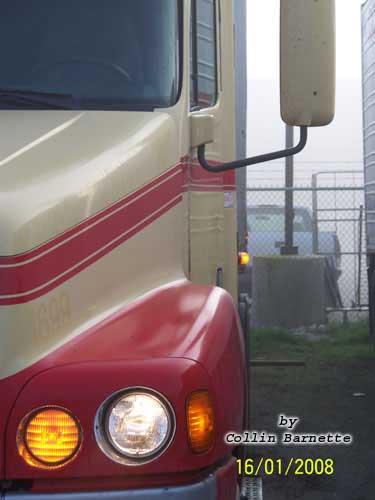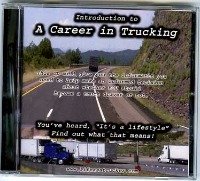How to Remember the
Pre-Trip Inspection
Many students are challenges with memorizing the Pre-Trip Inspection. At first, I found it difficult as well. Finally, I figured out to think about it in a more logical way in stead of relying so much on memorization. What should I actually be checking on a vehicle before driving it all day away from home?
Just remember repetition is the mother of learning. Don't give up because you are getting it as quickly as someone else. Keep reading the name of the parts and then going over the process. Each time more will stick with you.
Doing the Pre-Trip Inspection
by Collin Barnette
Well I’ve promised this so I will get it done for you guys and gals out there wanting to go into trucking. One of the most important things you will do time and again is to Pre Trip or Inspect your truck and trailer before you take off.
At the school I am attending there are about 140 items that should be checked each time you get underway. I know some drivers will tell you different things about this but I am just relating my experience.
As far as the DMV test is concerned, in my state you must perform this inspection with no more than 19 missed items. Of course remember you need to do your Air Brakes System Check first and that is a pass or fail 100 percent or nothing.
So let’s start in the cab. Is your seat belt secure and latched in place with no cuts or frays? Don’t forget to check the passenger’s side the same as your own. Mirrors clean with no damage and adjusted to you the driver? Does your horn work, are there any leaks? How about the Windshield, clean, no damage or leaks, no illegal stickers? Are the Heater/Defroster Vents free of anything blocking their use? Climate Controls working, fan, heat, defroster, fresh air, A/C? Do your Windshield Wipers work on high and low settings? How about the Windshield Washer? Let’s check the gauges, just the Oil Pressure, Water Temp and Volts, are they in a normal operating range for your truck? Remember we already checked our air gauges.
I know there can be a lot more but the DMV is just after these. Check your Headlights, high (indicator) and low beam working? Are the Left and Right Turn Indicators both working? How about the Hazard Light Indicators? Your Steering Wheel should have no more than two inches play in a twenty inch wheel. Now check your pedals, Clutch, Brake and Accelerator pedals secure and working with no debris blocking there use? So far so good now let’s go out side.
Stand out in front of your truck and take a look. Is the Wind Faring secure with no damage? Are the Cab Lights working? Again is the Windshield good? Out here you can get up there and insure your wipers have proper tension and good rubber. Can you spot any damage to the mirrors? Check your Headlights to ensure they are clean and working. On a personal note maybe you could see that they are properly adjusted. Are your turn signals, hazard lights clean and working (amber to the front red to the rear)? Is the license plate secure and up to date? Look under the truck for leaks and here is a good time to step back and see that the truck is not leaning. We are moving right along.
Now let’s pop the hood and see what’s going on under there. I know there are differences between trucks so I will just get the items listed and you may have to adjust what ever truck you're looking at.
Is the Radiator secure with no leaks? It’s a good idea to check it daily when the truck is cold. What’s connected to the radiator? You want the water hoses to have no cuts, bulges or leaks. Can you see that your water pump (belt or gear driven) is secure with no leaks? Check the fan and alternator belts to make certain they have no cuts, frays, or cracks and that they have no more than ¾ inch play.
Make sure the alternator is secure with no damage. It’s important that the wiring has no cuts, frays or broken wires and that it is in a proper loom. Check the engine oil with the oil dip stick at least daily and if necessary add at the oil filler tube.
OK let’s go around to the driver’s side.
I like to start at the top and work my way down and out, identifying components as I see them so as to not leave anything out. Check the Coolant Overflow daily for leaks and the proper level. Is the Air Conditioning Compressor secure, no leaks? Check this belt the same as you would the others. Check your Power Steering Reservoir daily for leaks and proper fluid level. Can you imagine loosing your power steering?
Identify and check the Fuel Pump, Air Compressor, and Power Steering Pump for damage and leaks. All three of these are gear driven. As you walk around also look over the Frame for bends, cracks and broken welds. OK, move up to the Steering Column and ensure it is secure and properly lubed. Also make a verbal note here that the column should have no hard spots when turning. Is the Steering Gear Box secure, all mounting bolts present and tight, no leaks? How about the high pressure hoses for the steering, secure with no cuts, kinks or leaks? You see I try to keep things flowing but that darn old frame is right there.
Moving along, we have the Pitman Arm, Drag link, Idler Arm and Tie Rod, are they secure, no damage, properly lubed? If something comes loose here there will be trouble. Look for the mounting hardware to be present, including cotter pins. That should do it for the steering so now the suspension. Spring Hangers, all mounting bolts present and tight? Check over the Leaf Springs, no more than 25 % missing or broken? Remember checking for leans out front? This would be a cause. Have a look at the U Bolts that keep the axel in alignment. Are the bolts all present and tight? Cool! Shock Absorbers, are they secure with no damage and not leaking?
That about does it for the suspension and steering so we’ll move on to the brakes and other items. Bake Lines should be secured at both ends with no cuts, kinks or leaks, next the Brake Chamber, secure, no leaks or dents. Now check on the Slack Adjuster, again secure, properly lubed and no more than 1 inch of play when the brakes are applied. Next the Brake Drum, no contamination and no cracks. Now the Brake Lining, No less than ¼ inch life left. All Good?
Check the inside and outside of the Wheel to ensure there are no cracks, dents or welds. Make certain all the Lug Nuts are present and tight. White powder on an aluminum wheel or rust on a steel wheel would indicate looseness. Steering axles and tag axles have a Hub Oilier and could be checked daily for leaks, add if needed. Locate the Valve Stem and check it for leaks and damage. This is where you would check the tire with a gauge and make sure the tire is inflated to the manufacturers’ recommendation. Don’t forget to replace the dust cap. Finally the Tire, check the inside and out side for cuts, cracks, bulges and leaks. Steer tires should have no less than 4/32 tread depth and must be replaced with a new tire.
I can see this is getting a bit long but trust me all these things are important to your success. I promise it’s going to start to move a lot faster.
Moving to the driver’s side of the cab you get another chance to check the Mirror to make sure the mounting bolts are all present and tight. Demonstrate for yourself and the examiner that both your Outside and Inside Door Latches are secure and working. Show that your Window Crank is secure and working. Now move over to the Door Hinges and point out that they are secure with all bolts present and tight. OK? Right here at the side of the cab let the examiner know that in your Storage Compartment you have a fully charged fire extinguisher that has no less that a 10 BC rating, your reflective triangles and spare fuses. Let’s drop down to the fuel tank area.
Identify the Steps up into the cab and that they are secure and there is no debris blocking there use. Let the examiner know that you have checked the Fuel Tank That it is secure and the straps that hold it in place are tight, that there are no leaks. Tell the examiner that you can visually check your fuel here by removing the cap just like you would do on the other side to ensure the fuel crossover is working.
Move on to the Battery Box, it is sure and properly latched. The Batteries are secure and the water levels are correct and caps tight. I know most new batteries are sealed but this is what they want to hear. Battery Cables should be secure, with no corrosion, cuts, frays or broken wires. Moving on to the Back of the Cab/Headboard, point them out and say that they are secure with no damage. Front of the Trailer, while we are here, showing no damage. Clearance Lights, even reflectors, secure and working? Check the Air Line Glad Hands to ensure they are secure with no leaks and good rubber.
Air Lines, are they secure to the tractor and trailer with no cuts, kinks or leaks? The Electrical Cord should also be secure to the tractor and trailer with no cuts, cracks, or frays and nothing hanging down to get caught and pulled from it’s connection. Is the Cat Walk across the frame secure, everything off of it? Look down to the Drive Line, all secure, no damage, properly lubed?
Here is an area that gets a little sticky for a lot of students. On this truck we have two drive axles and the below items are going to be in plural. We are going to say to the examiner that we will check these parts the same as the front with a few exceptions. So here we go. Torque Arm (exception, there isn’t one the steering axle) secure no damage, Spring Hangers, Leaf Springs, U-Bolts, Shocks, and Air Bags all secure no damage, air bags fully raised on both axles ( no air bags on the front either). Brake lines, Brake Chamber, Slack Adjuster, Brake Lining,
Brake Drum, see we are letting the examiner know we are thinking about these things but we have already demonstrated we know what to look for and we are just pointing them out. Wheels, since these are duals we will identify them so, inside, inside, inside, outside. Lug Nuts, just like the front. Sealed Hub, on the steering axle we had a hub oilier, but we would check this for leaks also.
Valve Stems, yes they are secure and not leaking but are they crossed from one another as they should be, meaning outside on one side inside on the other so you can get to both?
The drive axle Tires are check for the same condition and inflation as the steering tires but these can have no less than 2/32inch tread life left and can be re-grooved or recapped but never mismatched. While looking at the tires check for debris in between the duals.
The drive axles done move on to the Fifth Wheel and again start at the top and work down as you see components. Apron, you know the plate on the underside of the trailer, no cracks. Is the Kingpin straight (not bent) and the locking jaws of the skid plate locked around the shank? Can you see any daylight between the trailer apron and the Skid Plate, giant horseshoe shaped component, is it properly lubed? Is the Locking Arm secure in the locked position?
The Slider should be properly lubed, all the mounting bolts present and tight and no cracks, or broken welds? Also say the there are no missing or broken teeth and that it is in the locked position. And of course the slider moves back and fourth on the Platform which again you want to ensure is secure; as in no cracks or broken welds and all mounting bolts being present and tight.
Look at the Splash Guards (Mud Flaps). Are they secure and not higher than eight inches from the ground but no lower than six? Finally the Tractor Tail Lights tail, brake, turn and hazard all working and secure and, if equipped, point out the reverse lights. Whew! Now we move to the Trailer. Don’t be nervous or think the examiner is not listening they do this all the time.
We already checked out the front of the trailer and some clearance lights but since we are right here let’s look at the trailer Landing Gear. Is the Landing Gear secure with no damage and fully raised? Also point out that there is no debris on the pads and that the crank is in the stowed position.
It helped me to squat down and indicate to the examiner that the Trailer Ribs should be all present and not damaged. Indicate the Trailer Air and Electrical Lines and state that they should be free of cuts, cracks, kinks, frays and leaks and nothing should be hanging down. Stand up am motion up and along the Side of the Trailer. Tell the examiner that you are looking to see that there is no damage to the lights and reflectors, that all are secure are working (amber to the front and red to the rear). Good? Good!
Almost done; bend down and indicate the Trailer Sub Frame. And just like the tractor frame it should have no bends, cracks or broken welds. Note the Trailer Axel or axels and say that you would check this one the same as you would the second and third axels.
Torque arm, spring hangers, leaf springs, U-bolts, brake lines, brake chambers, slack adjusters, brake linings and drums, Wheels (inside, in between and outside), lug nuts, hub oilier, valve stems, and tires all the same condition you would look for on the rest of the combination. Here you should find another set of Splash Guards and you know to say that they should be secure and no lower than six inches to the ground but not higher than eight. Swing around to the Back of the Trailer. Looking up you indicate and state that the Clearance Lights are secure and working. The Trailer Door(s) is/are secure and can show slight damage but must be serviceable.
If there are Tension Cables, point them out and note that there is proper tension and no frays. Is the Door Latch secure and in the locked position? Is the Door Handle secure? Are there Reflectors that should be secure? The Trailer Lights, tail, turn brake and hazard all working and secure? Does you trailer have a Pintle Hook for a second trailer? If so it should be secure with no damage and no air leaks.
Is there a Safety Chain Hoop, also secure? Make sure the License Plate is secure and up to date. If there are Glad Hands on the back of the trailer, ensure that they are in the off position and not leaking. Lastly let the examiner know that the D-O-T Bar is secure.
As you walk the examiner around the right side of the trailer let them know that you would check this side of the combination the same as you would the left and point out any exceptions. Some trailers have the crank for the landing gear on this side. Don’t forget the Trailer side door if there is one, same as the back. Point out the air line to the fifth wheel slide and indicate that it should be happy.
Finally stop and indicate the Exhaust System and say that you would check it for damage and leaks. Exhaust leaks could be a real headache, literally, in the winter months. Now take a second or two and think if you’ve overlooked anything. This is your last chance to get it in. Feel Good? Turn to the examiner and say “This Completes My Walk Around!!”
I hope this gives you folks out there starting into trucking an idea of the sort of stuff the driver has in their mind every day. Let me know how I did.
Back to Collin's blog
Truck Driving Schools
Pre-trip Inspection Top
- Tips for New Drivers
- Becoming a Truck Driver
- CDL Training Options
- Advantages and Disadvantages
- Trucker Slang and CB Talk
- Types of Truck Driving Jobs
- Choosing Trucking Company
Tips For New Drivers
- New Driver Road Tips
- Truck Stop Tips
-
What to take with you
- Healthy Trucker Tips
- Dating - Relationship Tips
- Tips for Handling Stress
- Tips for Insomnia
- Making Extra Money
Types of Trucking Jobs
- Auto Haulers - Car Haulers
- Bull Hauling Jobs
- Class B Drivers
- Company Drivers
- Containers Haulers
- Dedicated Trucking Jobs
- Flatbed Trucking Jobs
- Freight Hauler - Dry Van
- Grain Haulers
- Household - moving company jobs
- Local Truck Driving Jobs
- LTL - Less Than Truck Load
- Oilfield Trucking Jobs
- OTR Trucking Jobs
- Owner Operators
- Refrigerated Freight
- Regional Trucking Jobs
- Tanker Jobs
- Team Drivers
Popular Pages
- Over The Road Trucking
- New Driver Tips
- Truth About Accidents
- Dating and Relationships
- How Much Truckers Get Paid
- Staying Healthy OTR
Thinking About Trucking? Share this site with your friends
Life As A Trucker Presents...
Ride With Me for Motivation
Use Trucking To Change
Bad Habits









New! Comments
Have your say about what you just read! Leave me a comment in the box below.